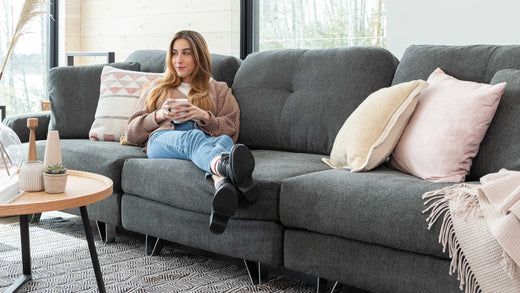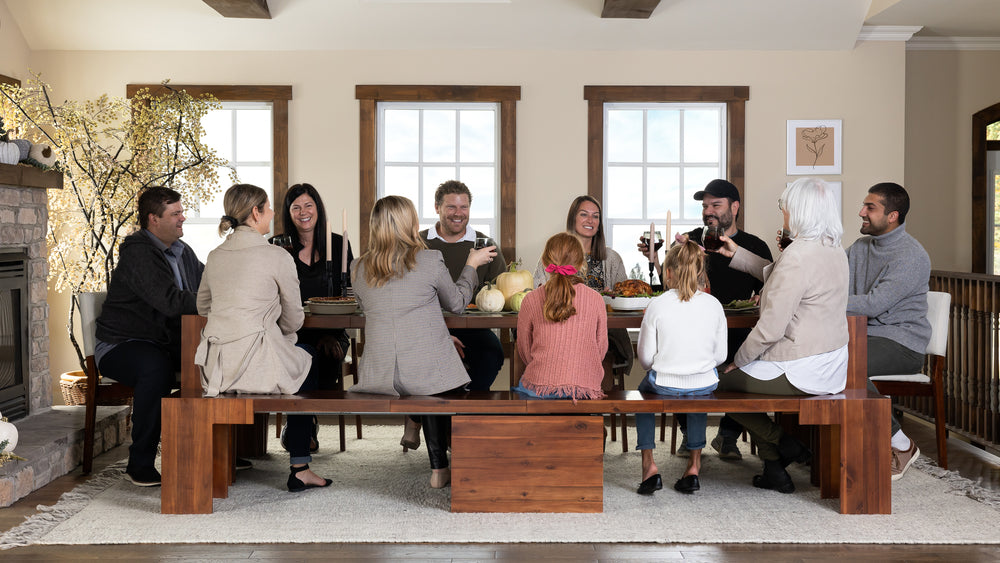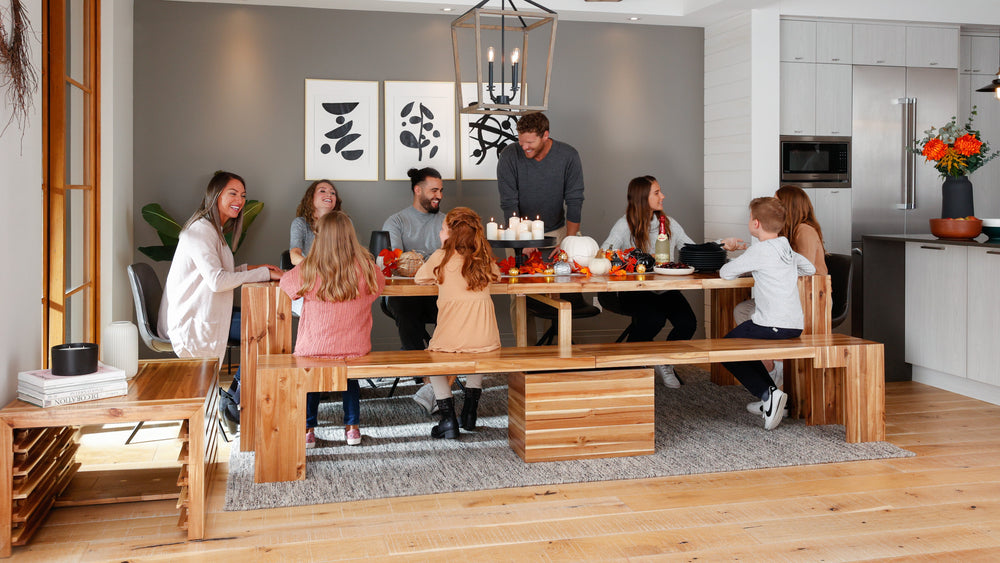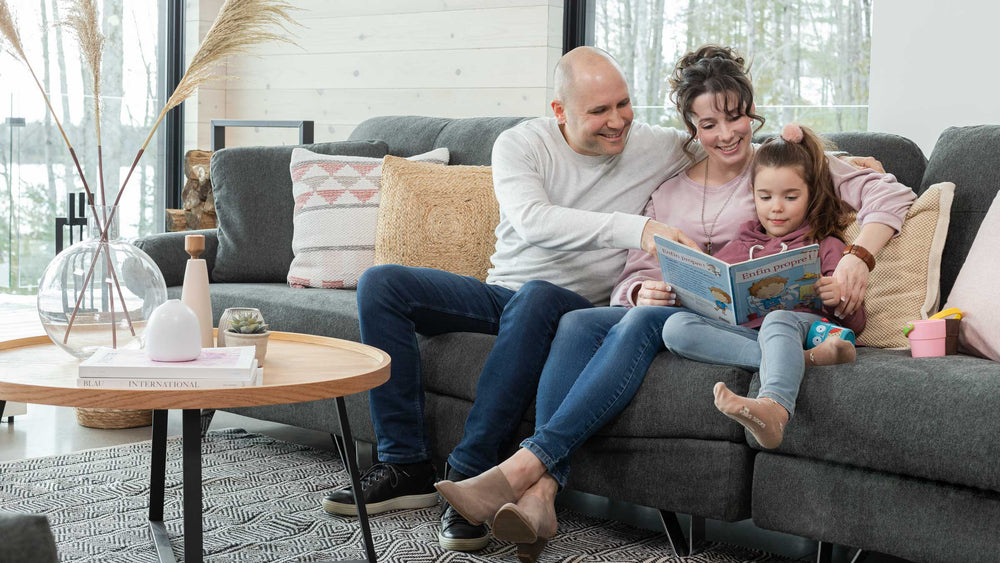
How To Decorate A Small Living Room

May 27, 2024
Decorating a tiny living room can be a frazzling experience, especially given the numerous factors to consider (space constraints, clutter, lighting, color scheme or theme, and so on). Don't be concerned! This post will help you make the most of your living area.
How Do You Make a Small Living Room Look Bigger?

The first step in maximizing space is to keep clutter to a minimum, perhaps by getting rid of old furniture or compartmentalizing miscellaneous knick-knacks in neat storage boxes (you could also repurpose some items that have sentimental value but are ultimately unused and turn them into statement pieces for your living room - dad's old vinyl records anyone?).
Secondly, you would need to consider the space required for walking through the tiny living room, keeping your furniture pieces and electronics out of the way to optimize your footpath is imperative, as cluttered living rooms lead to bumped shins and an overall unpleasant experience.
Decorate with Stripes to Make Small Living Rooms Feel Bigger
Whether you prefer plain white stripes, nautical blue and white stripes, or more daring colors like black and soft purple, striped living room walls draw attention to the ceiling and make it appear higher than it actually is, making a small living room appear much larger!
You can have the stripes painted for a more DIY homey vibe, or striped wallpaper for a more contemporary trendy style.
Light Colors Make the Room Look Larger
A less showy color scheme could also work in your favor to make the most of a small room. Using lighter colors reflects light a lot easier, and gives the illusion of receding walls, making your compact living room seem much larger.
White walls are ideal for this because a room with a lot of natural light can really make your entire room feel airy and clean.
The best part is that you can play around with the colors of your furniture or, if you lean towards an all-white color scheme, playing with the textures of your furniture and its accompaniments will enhance your space.
Reclaim Storage in Small Living Rooms
Every inch of precious floor space counts in compact living rooms, so why not make the most of it by utilizing the areas behind or between pieces of furniture?
For instance, if you have a sofa adjacent to an open space, why not add a tiny cabinet to store reading materials and a lamp? Install some narrow shelves (if you have the vertical room for it) close to the free space beside the wall-mounted TV to store your books.
Extra Seating Tucked Away Under the TV
The power of the tuck is not to be underestimated! Extra seating beneath the TV is an excellent way to maximize the tiny space, whether you choose a comfortable lined bench or a basic wooden bench that spreads sideways to make space for big bookcases or a couple of footstools at the side of your mounted TV.
What to Consider When Planning on Decorating a Small Living Room
Creative problem-solving is the peak of transforming your little living room from a broom cupboard to an expansive haven. Of course you won't have a hockey rink in your living room. So to utilize a tight space requires deft and a few tricks up your sleeve. Let's start from the walls in, shall we?
Opt for Neutral Walls
A neutral-colored wall is a lot like a blank canvas, and having neutral walls make your space seem a lot larger and brighter than it really is. Opt for the big three of neutral colors; white, beige, and gray.
With these shades, you may play around with colorful accessories and if you've got a room with a lot of natural lighting, take advantage of this by utilizing standing or hanging plants to make the room an airy feel.
Pairing your sofa and walls is a breeze, and we'll break down the best sofa colors for each of the big three neutral shades;
-
For beige walls, opt for black furniture - which may seem intense but it serves as an eye-catching focal point for your living room, if you prefer the opposite end of the spectrum, white goes well with beige too so you'll have more room to keep things light and warm.
-
For white walls, the concept of layering comes into play. You can keep white sofas. Alternatively a light gray, or brown, or even go crazy with colors like green or blue. Just be sure to keep your sofa and accessories coherent and play around with textures to keep things interesting.
-
For gray walls, it's important to keep a sense of balance as too much can make your living room look dark and dreary. Choose from a variety such as white, brown, gray, red, ginger, blue, green, and even yellow.
Use the Same Color On Walls, Woodwork, and Furniture
While using a uniform color scheme may seem drab, it can be an advantage to making the most out of valuable space. For example, let's say you're really into a clean-cut, minimalist type of space and you want to keep a lot of your area white to bounce light in the room.
You can paint the walls white and use white woodwork with good grain and solidity for texture, and perhaps use a varying shade of white for the sofas and chairs while keeping the texture of the fabric in mind as well so that your living room looks clean and has enough variation to break the monotony of uniformity.
This is where your accessories will shine, as you can play around with the color, texture, pattern, and size of the curtains, cushions, throw pillows, etc.
Use a Variety of Heights and Depths

Use height to your advantage and draw the eye upwards, with hanging decorations, lamps, and ceiling windows to keep the living room arrangement feeling well-thought-out and substantial.
Keep your furniture away from the walls as much as possible, especially so if your living room is a shared space with a kitchen. Keep the back of the sofa facing the kitchen to create an invisible division.
Painting the ceiling the same color as the walls also draws attention to whatever may be the focal point in the middle of the room and creates a sense of scale that instantly makes the space feel larger.
Hang Small Artwork
Small artwork is perfect for those who enjoy hanging multiple paintings, posters, or pictures and it keeps your living room looking a lot more sleek and can add visual interest.
If you prefer going bigger, stick to one big piece of wall art and work your way from there. A general rule of thumb when decorating with wall art is to leave 40% of it untouched and 60% decorated.
Stick to a Clean Color Scheme
Whether you're into boho-chic, beach-inspired, or a simple modern and contemporary look, picking a clean and consistent color scheme will set the mood for your room. A rule of thumb to keep your color scheme fresh is to work with three colors and go from there.
Decorate With a Light Color Palette
Light colors make things feel more open and cheery. Let's use the image below as an example; the walls, flooring, and sofa are white and the soft texture of the sofa contrasts well with the slightly nautical look of the white floorboards, and lastly the stark white blank canvas as a point of visual interest.
The accentuated furniture is all wooden, which produces a beautiful polarity, but notice how the brown of the wood is still light enough that it doesn't feel like an eyesore and blends well with the plants in the space, producing a rustic and contemporary look.
Choose Dark Colors but Balance Them With Light
When utilizing dark hues in your layout, remember that lighting and contrast are your best allies, since too many dark swatches might make the room feel like a little black hole.
Keep a balance between bright, accent pieces, like the sofa in the image above, and play around with both natural light and artificial light as well (bold, and warm lamps create a cozier feeling as opposed to cool lighting).
Comfortable White, Gray, and Black Room

Black and white provides a sense of sophistication and elegance to any living room, and incorporating gray into the mix to create some color breaks is a terrific way to keep your area looking minimalist. Set some potted plants on each side of the sofa to offer a splash of color.
Even a smoky-toned sofa like a dark grey 3-seater sofa can be a great asset to adding a point of visual interest in a monotone living room. Don't forget to provide adequate lighting and accent pillows in the right color.
Add Texture
You can add character to your modest living space by using textures on decorative items like throw pillows, carpets, and blankets. You can even add a bit of visual intrigue by accenting a wall in your home with metal or wood.
Fluffy White Accents Lighten the Room
You may want to play up the little details in an all-white living room to make it even cozier.
This serves as the perfect layering, and bonus points if you've got the sofa situated by your window frames, let the light magnify the details of your living space, remember, white reflects light!
White Sofa with Colorful Cushions
Who says white sofas have to be boring and match all the time? Add splashes of color to your sofa, as this will highlight the contrast between the bright sofa and the even brighter cushions!
Streamline your living room and play up the details, like the image above, for example - contrast the sofa with not just the accented cushions, but the wall color, and the starkness of the pink flowers and vases.
Grey Chaise Sofa with Plump Cushions
Instead of a conventional sofa, add a two-seater with double chaise to maximize the room. This also offers your seats an edge because you'll have comfortable legroom for long periods of reclining, and plump cushions may be a most attractive touch to any small space.
Take the above image for example, it has an empty storage compartment underneath both the detachable ottomans and you may detach the chaises as well if you're in need of more seating for unexpected guests (it would be great practice to design your small living space around the idea of expandable seating).
Cozy Accent Chairs
Sofas can be a terrific addition to a family room or a great place to congregate with friends, but accent chairs are a popular alternative.
These seats conserve room and may be positioned to face each other for a discussion with loved ones or to face the television.
A great coffee table in between four armchairs is the perfect set up or alternatively, you can slot two side tables next to each other between each chair for a perfect halfway point to reach for refreshments without interrupting the conversation.
Embrace a Multipurpose Room
The first rule of creating a multipurpose room is to start with multi-purpose furniture. Like this coffee table, which doubles as hidden storage, or a modular sofa that can adjust to suit your space and seating requirements.
If you have the space and your coffee table isn't an issue, you could even wedge in a small dining table, particularly one that is collapsible and fits the compact space nicely. Also, consider using side tables as extra seating.
Use an Upholstered Ottoman
Opt for Compact Furniture – Upholstered in Patterned Fabric
Try to avoid massive sofas and rather work with a loveseat or even armchairs and accent chairs instead. With small space living, work smart not hard.
Reupholster or get them readily upholstered in a pattern of your choosing to add zest and an instant focal point to your sitting room.
Separate Zones with Area Rugs
Another trick to creating the illusion of space is to add rugs to separate your living room from say, your dining room. A charming living room with a rug that both draws the eye to the focal point and keeps the floor clear and spacious.
Pieces with textured carpets and tactile fabrics may create a truly appealing and comfortable atmosphere and make all the difference in small living room designs.
Layer Your Lighting
Lighting creates the mood so be aware of the soft textures, the walls parallel to your windows, and any facet of your small living room design you wish to highlight.
This applies not only to natural light but also to artificial light.
For example, using a table lamp in a corner where natural light does not reach keeps the space illuminated without feeling overbearing, or another great example would be to have wall lights over your floating shelves to focus attention on the collection while also making nighttime reading easier.
Optimize Natural Light
Use as much light as you can but don't overdo it, highlight it! Start with a natural focal point and work your way outwards.
Remove heavy curtains, as this will block any natural light coming in during the day, opt for sheer window treatments or blinds to optimize the lighting during the day to illuminate your seating area. Furthermore, wide horizontal slats serve to create the idea of a larger space.
Hang Mirrors Opposite Windows
Mirrors create an impression of depth and can make the space feel much more interesting in small rooms.
Hang a mirror on the wall opposite a window, to reflect the light and create the illusion of more space. Mirrored walls and glass tabletops will provide the impression of a more open flow.
Mirrored cabinet doors can also be utilized to make rooms appear larger and less cluttered, which is a less evident purpose.
Don't Overlook Underused Spots

Don't overlook extra space in those tiny places, be it coffee tables, or window sills - all the furniture you have has some extra space you can utilize.
Use the free space to place decorations like an empty spot next to the sofa for floor lamps, or use the window sill to house an awesome collection of succulents basking in the light.
Visual space is all about utility and practicing these small living room ideas will give you a better sense of how to save space and structure your living room.


